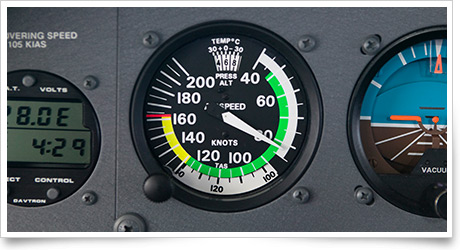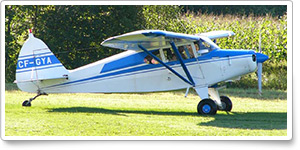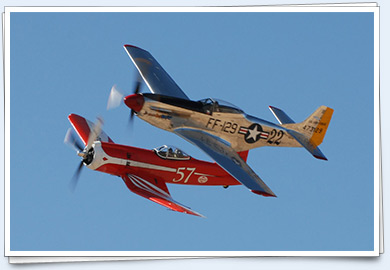Dec. 7, 2012, issue of 'AOPA ePilot: Flight Training Edition' weekly newsletter
| ||||||
| Colorful warnings |
| |||||
Training TipsColorful warnings
Fortunately, color-coded airspeed indicators installed in FAA-certificated aircraft manufactured after 1945, and of 12,500 pounds or less, can alert the pilot at a swift glance to airspeed in need of correction during the approach and landing sequence.
Downwind, preparing to decelerate and descend, the pilot reduces power to a predetermined setting and maintains altitude with gentle back pressure to slow the aircraft from the normal operating range (green arc) into the approach-speed realm (white arc). When the airspeed enters the white arc, the aircraft is ready for configuration changes.
The white arc is “commonly referred to as the flap operating range since its lower limit represents the full flap stall speed and its upper limit provides the maximum flap speed. Approaches and landings are usually flown at speeds within the white arc,” explains Chapter 7 of the Pilot’s Handbook of Aeronautical Knowledge. (Questions on this subject appear on the Private Pilot Knowledge Test; review Learning Statement Code PLT088.)
Retrimming hastily for the new configuration is frequently a cause of airspeed errors. Be sure the aircraft has stabilized under the new power-pitch-flaps combo—or the outcome will not be what you had in mind.
Stabilized? Power changes can now control the descent until you change the flap setting again, when retrimming will again be needed. If you plan to maintain the current airspeed when adding flaps, remember to lower the nose to offset the additional induced drag.
The airspeed indicator’s color coding—including the cautionary yellow arc, and the red radial line depicting V NE (never-exceed speed)—sends easy-to-interpret safety messages in other phases of flight such as cruise flight and during maneuvers.
Not all important airspeeds are depicted. Practice locating other values such as design maneuvering speed, and speeds for best rate and best angle of climb, finding them on placards or in your pilot’s operating handbook, for easy reference now, and to demonstrate knowledge to the designated examiner during your flight test. Flight Training NewsSpace industry gears up crew trainingA crowded field of contenders is vying to produce commercial spacecraft in the next few years, and those spacecraft will need pilots. The National AeroSpace Training and Research (NASTAR) Center, a subsidiary of Environmental Tectonics Corp., has added spaceflight training to its aviation programs for government and commercial operators. Read more >> Radar appsThis week, AOPA e-Newsletter Editor Benét J. Wilson took a look at radar apps, since so many members sent in some great ones, including My Radar Weather Radar, Plane Finder, FlightRadar24 Pro, FlightAware, and Flight View. Read more >> Cirrus, Poland’s Aero Poznan offer flight training packageThe Cirrus Training Center (CTC) at Poland’s Aero Poznan is now offering those with a Joint Aviation Authorities/European Aviation Safety Agency (JAA/EASA) pilot certificate the chance to add an instrument rating in less than three months and get full Cirrus Transition Training at the same time—all in one package. The Integrated Instrument Rating Training with Cirrus Transition Training Course (IIRT/CTTC) is designed for JAA/EASA certificated pilots who wish to meet the demanding European instrument rating standards and get in-depth transition training for the Cirrus SR22/SR22T at the same time. It is more than just a number…The average general aviation aircraft is more than 30 years old—at least on a calendar. A number of factors contribute to an aircraft’s true age, which may not be the same as its age in calendar years. Learn how to recognize the signs of aircraft aging, understand its effects, and mitigate the risks by taking the Air Safety Institute’s Aging Aircraft online course. Take the course >> Training ResourcesEver wished you knew more about what was going on beneath your aircraft’s cowling? A good understanding of engine and propeller operation can help you keep operating expenses low, avoid costly repairs, and prevent damage that could lead to an accident. The Air Safety Institute’s free Engine and Propeller online course is a great way to pick up all the need-to-know facts without wading through a textbook. Get started >>
Did you know that student pilots who join AOPA are three times more likely to complete their flight training? Membership includes unlimited access to aviation information by phone (800/USA-AOPA, weekdays from 8:30 a.m. to 8 p.m. Eastern time) or from Flight Training Online or AOPA Online. If you’re not already a member, join today and get the pilot’s edge. Login information is available online. AOPA Live: ‘Top Gun’ to GA cockpitNew general aviation aircraft that are twice as safe and cost half as much to certify? AOPA, the FAA, and others are hard at work making that a reality. We talk with Anthony Edwards—Goose from Top Gun—about becoming a pilot. And find out how you can save money on your taxes and help AOPA in a recent edition of AOPA Live This Week. Career PilotPilots are optional in FirebirdOne of the last designs fully supervised by Burt Rutan before his retirement from Scaled Composites has reached the production level—and pilots are optional. Northrop Grumman, the parent company for Scaled Composites since 2007, has named the surveillance aircraft Firebird. It can carry two pilots, or not. Read more >> Girls Inc. organizes aviation inspiration eventGirls Inc. arranged for six girls to spend the afternoon at Chattanooga's Wilson Air Center with a female pilot as it helped celebrate National Aviation Month, reports the Chattanooga Times Free Press . The organization's program educator said the outing was designed to introduce girls to male-dominated fields. Plane SpotterPiper PA-20: An easy pace Training ProductsPilot Mall features flight bags, pilot luggageFlight bags play an invaluable role for pilots and aviators. With pilot bags, aviators can have quick access to navigation charts, flight plans, fuel testers, headsets, airport directories, portable GPS receivers, and much more. Check out a complete list of offerings from Pilot Mall to help with your holiday shopping for the student pilot in your life.
Note: Products listed have not been evaluated by ePilot editors unless otherwise noted. AOPA assumes no responsibility for products or services listed or for claims or actions by manufacturers or vendors. Member BenefitsUnderstanding the dangers of an understated hullHull coverage is the single most expensive part of your aircraft insurance premium, since hull claims are much more frequent, resulting in insurance carriers paying a lot more in hull claims than liability claims. Because the premium attached to your hull coverage is the most attention-grabbing line item on your quote you may be tempted to undervalue your aircraft to save a few dollars. Resist this temptation, as it could cost you your aircraft. Read more >> Medications update: Xarelto approved for aviation useIn some good news on the medication front, the FAA recently accepted Xarelto as an anticoagulant allowed for use in aviation. Xarelto (rivaroxaban) is a new type of anticoagulation drug that has a much more favorable side effect profile than its pharmaceutical cousin, Pradaxa (dabigatran). Read more >> Blogs‘Since You Asked’: Would you have canceled the flight?The November “Since You Asked” poll was prompted by a question asking digital respondents what they would do if the weather looks threatening for an upcoming dual flight. Eleven percent said they would cancel the flight on their own initiative. Read more >> iPad and iPhone appsAOPA e-Newsletter Editor Benét J. Wilson requested that readers of her AOPA blog post send her their favorite training and flight apps. Private pilot Blaine Transue took the theme and ran with it: “Since I am an avid geek when it comes to flying apps and during my training tested out a number of iPad and iPhone apps, here are the ones that I think are the best and most useful apps on the market for students and pilots alike.” Read more >> Flight controls and passengersHover Power blog author Tim McAdams notes he was at a state fair several years ago where a pilot was giving helicopter rides in a Bell 206 JetRanger (a five-seat turbine single-engine helicopter). What caught his attention was that the dual controls were installed and passengers were being loaded into the left front seat. Allowing strangers access to the flight controls, as in when giving rides, is very risky. Read more >> AOPA Career OpportunitiesEver dream of turning your passion for aviation into a career? We’re looking for an events coordinator; AOPA eastern regional manager; .NET applications developer; manager, AOPA Flying Club Network; Web developer (eMedia); and Web graphic designer. To learn more about other AOPA career opportunities, visit AOPA Online. Community
AVIATION EVENTS & WEATHER
| ||||||||||||||||||||||||||||||||||||




 The most reliable way to achieve a stabilized final approach, crowned by a
The most reliable way to achieve a stabilized final approach, crowned by a 



